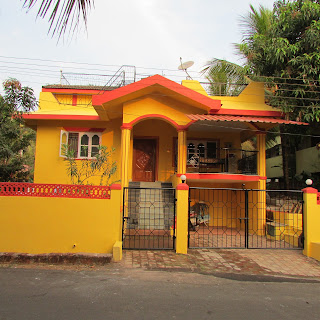Our house is
re-painted recently; now looks nice.....!
We got our house re-painted, interior and
exterior, and floor re-polished, recently after 13 years of our occupancy. I
remember that the initial painting at the time of construction of the house
with cream interior and lavender exterior with terracotta bordering, was very
methodical, well-done job and endured so long. Over
the years, there were quite a bit of additions and deletions on the walls and
roof which, together with wear and tear of the weather, deteriorated the
wall-paints and demanded a comprehensive repainting. Therefore, we went for a
thorough re-painting.....
As this exercise unfolded, we understood that
re-painting of a house is no small job.....! It is indeed a big, exhaustive exercise. Firstly,
we dismantled everything in the house. The house-hold materials were removed,
packed in plastic bags and shifted to another room or compacted at different
places in the same rooms. It was quite hectic for me and my wife and we took
almost 2 days to pack the materials. The wall-hangings, showpieces, mementos,
numerous toys that got accumulated by our children and now being used by our
grand-child, sizable quantity of my fungal reference books, utensils, tables,
chairs, kitchen utensils and everything....! For a while, the house was in a disarray.
I and my wife perched in one room in the house for several days until we got
the whole house re-painted and re-organized.
The process of wall repainting is quite
elaborate and at times daunting. Retired from service and sitting at home, I
observed the whole process of repainting. The old faded and deteriorated wall
paint was first scarped using a wire brush or scrapper. The wall-cracks were opened and re-filled
with a crack-filling cement material. The surface imperfections such as dents,
holes, depressions, cracks were filled or applied with a coating of wall-putty
which is a wall-adhering material. This was followed by an elaborate wall-scrubbing
process which resulted with eruption of a mild dust storm of powdered, dusty
wall-putty inside the house. I and my
wife used facial masks to avoid inhalation of dust and possible dust-allergy. We
cleaned the floor every day, soon after the workers left in the evening but the
wall-putty powder rained all through the nights until the primer was applied. Though
the dust induced repeated sneezing, fortunately we didn't face any allergic
problem from this dust.
The smoothed wall was coated with a primer as a base on which the wall paint was applied subsequently. The raining of wall-putty powder stopped
following application of primer. Next, 2-3 coats of wall paint was
applied. I guess, it was a water-based emulsion.
There are numerous shades of colours. I believe
there has been lot research on providing needful colour combinations onto the
walls. Colour charts spell out numerous such colour combinations, depending on one’s
taste. We left this to our children to choose appropriate colours, both
exterior and interior, and they indeed did well. Eventually we now have ‘wheat sprige’ for
interior and ‘burnished sun’ bordered with ‘geranium’ as exterior paint.
There are several reputed paint-manufacturing
companies in the Indian market. We went for the brand Asianpaints. I am aware of other
paint manufacturers are equally
good and very competing with their quotes. All wall-paint manufacturing companies,
including Asianpaints claim that their paints are good, competitive in price
and resistance to vagaries of weather and especially against algal and fungal growth. This
latter aspect, I am not very sure. I am a specialist on fungi and fully aware
that controlling fungal growth on a wet wall surface is not that easy. Though microscopic,
fungi are grow and subsist on organic matter by elaborating a variety of enzymes. During rain or when there is lot of humidity
and reasonably warm temperature, fungi grow everywhere on the wall paint which is a
water-based emulsion. That is how we see patches of fungal
growth on wall surfaces. It is not at all easy to control fungal growth. Fungi secrete
a variety of enzymes from their filamentous body which digest the paint
resulting with the wall paint loosing texture and dexterity.
Meanwhile, we also got the house-floors, partly
marble and partly mosaic, mirror-polished. This is also an equally elaborate
process. At the end of the day, the whole exercise resulted with even, smooth,
shining walls and floors. Indeed, our house now looks grand....!
D. Jayarama
Bhat
Our house before re-painting
Our house after painting (under morning Sun)
Our house after painting (as seen in the evening)





































